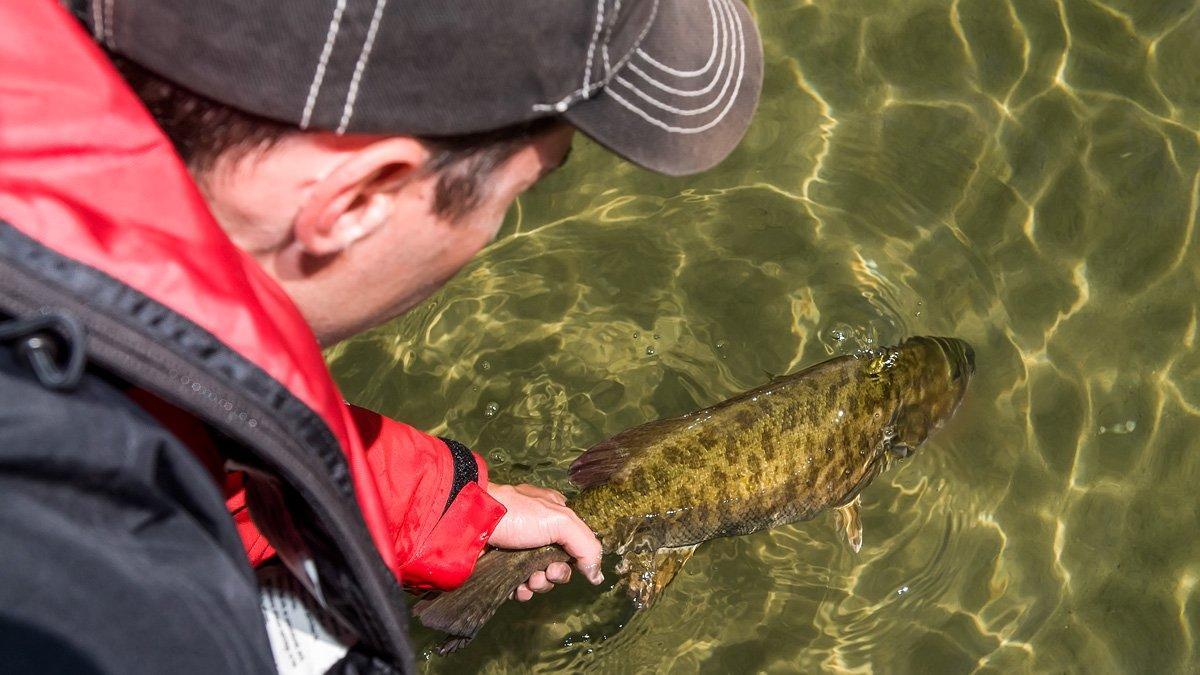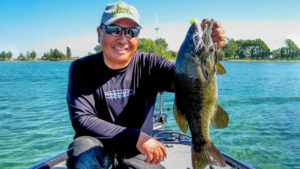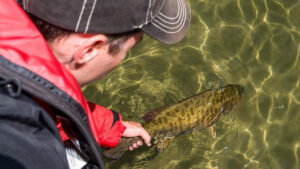Fishing for smallmouth bass in shallow water can be a reliable summer approach on many clear, northern lakes. Smallmouth move to sand flats and inside weed lines during hot, stable weather. Anglers will catch aggressive bass on spinnerbaits and jerkbaits, but finesse plastics, like tubes and stick baits, are the reliable choice for fussy smallmouth.
Dave Chong of Aurora, Ontario is a shallow-water smallmouth expert. The successful competitive angler and guide catches giant smallmouth in less than 6 feet of water from the Great Lakes and many smaller systems.
“I think it goes against conventional wisdom a bit because many people think that as the summer goes on and the water gets warmer, smallmouth all go deep,” Chong said. “Well not all do. There is a population of smallmouth that stay shallow. As long as there’s food available, there’s no reason for them to leave.”
Consider these 7 points when plying the shallows for smallmouth in clear lakes this summer:
- Prime conditions
- Shallow spots
- Covering water
- Hooking followers
- The Approach
- Effective Lures
PRIME CONDITIONS
A summertime abundance of baitfish, panfish, crayfish, gobies and other food draw smallmouth to shallow habitat. Hunting here gives smallmouth an edge. Prey have less time and space to escape an attack in thin water.
Smallmouth also go shallow to sunbathe. These sunning fish aren’t chasing food. But, like sun-worshiping tourists offered an ice cream cone, smallies grab snacks placed within reach.
“There have been many days in the summer on Lake Simcoe where the surface temp was over 80 degrees, and there were smallmouth up shallow,” Chong said. “It almost seems like the warmer it gets, the more they’re shallow.”
SHALLOW SPOTS
Chong favors inside weedlines and sand. The best shallow areas typically contain several structural elements.
Chong finds inside weedlines with a hard rock bottom between vegetation and the shoreline are the best overall. These stretches consistently hold quality smallmouth during prime conditions.
Variations along a weedline often concentrate smallmouth. Productive spots include an inside or outside turn, rock to weed transitions, isolated rock piles and sand patches.
“You find sand on a lake and at some point there will be shallow smallmouth cruising on it,” Chong said.
A sand bar is a hotspot. Smallmouth use the entire structure, from its shallow top to holding off the bar’s ledges.
Sand flats are equally good. Isolated rock piles, vegetation clumps and sunken timber will hold bass.
“Pencil reeds on a sand flat are another key spot for me,” Chong said. “Yes, smallmouth will cruise out in the open on the flat, but the pencil reeds are where the biggest fish are most likely to be.”
FINDING GOOD AREAS
When scouting water, Chong surveys weedlines using Lowrance’s Structure Scan. On the Great Lakes, inside weedlines are sometimes 15 yards offshore, ample room to navigate his Skeeter while side scanning the inside edge.
Smaller lakes require a different tactic. For thin weedlines up to 2 yards wide, he scans along the outside edge.
“Going along with Structure Scan, you can see where it gets thicker and thinner,” Chong said. “Usually where it gets thinner, there’s some kind of turn there, but you need to go inside and check it.”
Use Google Earth to find shallow sand. Shortlist prime areas for investigation on the water.
COVERING WATER
While electronics offer a starting point, Chong prefers quickly fishing a search bait through an area to determine its potential.
- Tracking them down – “Some sand flats are the size of a football field,” Chong said. “There may be a patch of pencil reeds here and a rock pile in the middle of the sand, but the smallmouth could be almost anywhere moving around, so sometimes you have to use search baits just to locate them.”
- Top bait – The compact, 5/8-ounce Ultra Tungsten T-Blade Spinnerbait with a white skirt is his top lure for covering water with long casts and speedy retrieves.
- Second choice – For less aggressive smallmouth, a Lucky Craft Flash Pointer 100 or other shallow-running jerkbait is used. A jerkbait’s retrieve can be varied, an asset for triggering following fish. Sexy Chartreuse Shad, Pearl Ayu and Ghost Minnow are top colors.
- Startle them – “I move through pretty quick because sometimes you need to spook the fish to see them,” Chong said. “Sometimes they camouflage so well that if you’re going slow and stealthy, you may not even see them. Obviously, if you see a smallmouth that’s as black as cole, it’ll jump out at you, though.”
HOOKING FOLLOWERS
For every smallmouth eagerly striking a spinnerbait or jerkbait, it’s typical there will be tailgaters throughout the day hesitant to bite. This is often the game in clear, shallow water.
“If you don’t have a quality pair of polarized glasses, you’re missing a piece of the puzzle,” Chong said. “The further away you can spot that fish, the better chance you have of getting them to hit.”
Chong wears high-contrast lenses, such as Vigor Eyewear’s Sunset Amber or All-Weather Rose. High-contrast lenses enhance colors and contrast, making it easier to see smallmouth, cover and structure than with neutral lenses, like smoke or grey.
THE APPROACH
No magic formula exists for catching following smallmouths, but varying the retrieve is a starting point. Speeding up can evoke a hit. Stopping a jerkbait is another method. Experimenting with color and bait size can also be what’s needed to push the right button and make a bass bite.
“You should always have a follow-up rod rigged and ready with a finesse bait, like a Senko,” Chong said. “A lot of times when smallmouth follow, you can catch them on a follow-up bait.”
When smallmouth won’t hit search baits but stay in the area, Chong pins down his boat with Power-Poles and sight fishes. Shallow-water anchors make using the trolling motor unnecessary, so there’s no risk of spooking smallmouth with its whirling blade. The boat’s fixed position also improves stealth and finesse tactics.
Keep quiet and avoid sudden movements. Commotion startles shallow fish and can ruin the chances of coaxing bites. Smallmouth are also spooked by boat and angler shadows.
EFFECTIVE CLEAR WATER LURES
A wacky rigged 4-inch or 5-inch stick bait and 3 1/2-inch tube with a 1/8-ounce jig are Chong’s go to shallow, finesse baits. Green pumpkin, smoke, baby bass laminates and other natural colors are preferred. Each bait is fished with 6-pound Sunline Finesse FC fluorocarbon.
“You need to lead a fish, casting 4 or 5 feet in front of the bass, in whatever direction it’s going,” Chong said. “You do not want to land your bait right on top of the fish.”
When smallmouth are milling around an area, Chong casts a tube to a fish and leaves it on bottom. He’ll gladly wait 5 to 10 minutes, letting the bass’ curiosity build.
“The more you move the bait after you cast it, the less likely you will catch that fish,” Chong said. “Just leave it, watch your line and if you feel anything at all set the hook.”
Try Dave Chong’s shallow-water smallmouth tactics this summer on your favorite clear lake. When it’s hot out, odds are there are plenty of smallmouth on sand and along inside weedlines in waist-deep water. Just don’t forget your polarized glasses.
CHONG’S SHALLOW WATER COMBOS
- Spinnerbaits: Daiwa Zillion 9.1:1 XTRA HYPER SPEED reel, Team Daiwa S 7-foot, 7-inch medium rod, Sunline Reaction FC 16-pound fluorocarbon
- Jerkbaits: Daiwa Certate 2500 reel, Daiwa 6-foot, 10-inch Fuego medium action spinning rod, Sunline SX1 16 pound braided line with a Sunline FC 12-pound fluorocarbon leader
- Finesse plastics: Daiwa Ballistic EX 2500 reel, Daiwa Zillion 7-foot, 2-inch medium-light spinning rod, Sunline Finesse FC 6-pound fluorocarbon

















